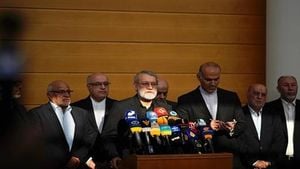In recent weeks, a series of Russian drone and fighter jet incursions into NATO airspace has shaken European capitals and triggered a flurry of military and political responses, culminating in the high-profile 12th Warsaw Security Forum held on September 29 and 30, 2025. As tensions simmered along NATO’s eastern flank, leaders from across Europe and the United States gathered to assess the threat, debate their next moves, and confront the uncomfortable reality of evolving warfare—and shifting alliances.
At the heart of the debate lies a blunt assessment from US Treasury Secretary Scott Bessent, who made headlines earlier this week by declaring that America would not intervene militarily if Russia pushed into NATO territory. Speaking to Fox Business, Bessent stated, “The one thing I can tell you is the US is not going to get involved with troops or any of that. We will sell the Europeans weapons.” According to Eurointelligence, this message, rather than President Trump’s often unpredictable rhetoric, represents the true policy of the current US administration. The implication is profound: the United States, long seen as the ultimate guarantor of European security, now signals a more transactional role—one that stops short of boots on the ground, even in the face of Russian aggression.
This policy clarification arrives as Russia appears to be deliberately testing NATO’s resolve. In early September, 19 Russian drones penetrated deep into Polish airspace, followed by three Russian fighter jets violating Estonian airspace. Suspicious drones also buzzed Copenhagen and Oslo airports, while a tense encounter unfolded between Russian jets and a German navy frigate in the Baltic Sea. German Defence Minister Boris Pistorius recounted the incident to MPs, emphasizing that German forces did not respond: “We are thus showing a clear response to Russian behaviour, but without alarmism. In other words, we are not falling for Putin’s provocations; we are not falling into this trap of escalation.”
While some European officials argue that measured restraint is the right approach, others worry that such caution could be read as weakness. According to Eurointelligence, Russian President Vladimir Putin is likely to interpret these restrained responses as an invitation to continue—and perhaps escalate—his hybrid war tactics. With Russia’s resources stretched by the ongoing conflict in Ukraine, the Kremlin appears to be leveraging drones and sporadic airspace violations to expose NATO’s political divisions and outdated defenses, rather than to launch a full-scale military campaign.
Yet, on the military front, NATO’s systems have proven robust. As detailed in a recent analysis, Russian MiGs were promptly spotted, intercepted, and escorted out of NATO airspace, with no loss of control or escalation. Drones were either shot down or crashed after running out of fuel. “Militarily, NATO passed with flying colours; politically, NATO allies deserve a ‘D’ at best,” observed one commentator, highlighting the alliance’s technical competence but also its political jitters. The effectiveness of these military responses, however, does not mask the vulnerabilities exposed by the new era of drone warfare—vulnerabilities that have become all too apparent in Ukraine and now threaten to spill over into Western Europe.
The political reactions to these provocations have been, by most accounts, less assured. Polish Foreign Minister Radosław Sikorski, speaking at the Warsaw Security Forum, warned, “Russians were testing us. Our government, our society, and our alliance all have worked. Russia made a mistake by sending the drones into Poland.” Yet, Sikorski also revealed that Warsaw had asked Beijing to intervene with Belarus, Russia’s close ally, underscoring the diplomatic anxiety running through European capitals.
At the same time, the invocation of NATO’s Article 4—allowing member states to consult when their security is threatened—prompted emergency sessions and UN Security Council meetings. Critics argue that such measures, taken over incidents lasting mere minutes, risk appearing disproportionate and may embolden Moscow by projecting European insecurity. As one analysis put it, “If every Russian provocation triggers a NATO consultation and forces the president to make public statements, there is a risk that Europe will cry wolf once too often—and that Trump will then ignore events across the Atlantic when it really matters.”
These concerns were echoed at the Warsaw Security Forum, where President Volodymyr Zelensky of Ukraine called for a unified response—a “joint, truly reliable shield against Russian aerial threats.” Zelensky stressed that “if Russia loses the ability to strike in the skies, it will be unable to continue the war and will have to look for other ways to coexist.” He also congratulated Moldova for resisting Russian interference in its recent parliamentary elections and warned of the dangers of losing countries like Georgia and Belarus to Moscow’s influence. “Every gain for Russia in our region is always a loss for Europe. That is why we cannot afford to lose a single day or a single country,” Zelensky said.
Other voices at the forum reinforced the urgency of strengthening Europe’s defenses. Georgian former president Salomé Zourabichvili called for more EU support, while Belarusian opposition leader Sviatlana Tsikhanouskaya cautioned that as long as Alexander Lukashenko remains in power in Minsk, “threats and provocations against our democratic neighbors will continue.”
European leaders are responding with new initiatives. The European Union, under the leadership of Commission president Ursula von der Leyen, has thrown its weight behind Estonia’s “drone wall” proposal—a plan to bolster air defenses using a combination of European and Ukrainian technologies. “Our capabilities in detecting and destroying drones need to be rounded up and he can learn a lot from Ukraine,” said Andrius Kubilius, the EU’s Space and Defense Commissioner. Germany, for its part, has pledged to send two additional Patriot missile defense systems to Ukraine by year’s end, with support from Norway.
Despite these steps, the mood in Europe remains anxious. The Baltic Sea, described by Swedish Civil Defense Minister Carl-Oskar Bohlin as a “chessboard for hybrid warfare,” has become a focal point for both military and political maneuvering. Concerns about the security of critical infrastructure are mounting, and Zelensky has even suggested that Russia may have used tankers in the Baltic Sea to launch drones targeting northern European cities.
Meanwhile, the debate over how best to respond to Russian provocations continues. Some officials advocate for a more assertive, “peace through strength” doctrine, urging NATO members to react calmly yet decisively, closing gaps in drone defenses while projecting confidence. Others warn that overreaction could play into Putin’s hands, fueling his narrative of Western weakness and division.
As the Warsaw Security Forum drew to a close, one message was clear: Europe’s security landscape is shifting, and the old certainties of American protection can no longer be taken for granted. The continent faces a new kind of war—one fought with drones, disinformation, and political pressure as much as with tanks and missiles. Whether Europe can rise to the challenge, forging unity and resilience in the face of Russian hybrid warfare, remains the defining question of the moment.





